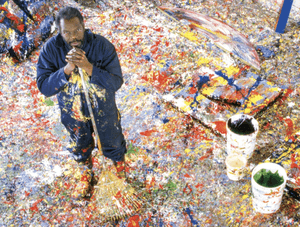Sam Gilliam
Sam Gilliam, born in Tupelo, Mississippi in 1933, is now regarded as a prominent figure in the development of late 20thC and recent contemporary art. His unique approach to colour and abstraction challenged the boundaries of traditional painting, making him a prominent figure.
Gilliam's artistic journey began in Louisville, Kentucky, where his family relocated during his childhood. He demonstrated an early interest in art, which led him to enrol in the University of Louisville. There, he pursued a degree in painting and gained a solid foundation in traditional techniques, studying under prominent artists such as Robert Plate and Charles McAfee. After completing his studies, Gilliam relocated to Washington, D.C., where he became associated with the Washington Color School, a movement that investigated colour field painting and abstraction.
Gilliam's early works from this period, characterised by large, colour-saturated canvases and unique explorations such as his "Drape" Paintings were amongst his most significant contributions to art.
In the late 1960s, he began experimenting with techniques that challenged the traditional notion of the canvas as a flat, two-dimensional surface. Gilliam's breakthrough came when he started suspending his paintings from the ceiling, allowing the canvas to hang freely, creating a sculptural effect. These groundbreaking works, known as the "Drape" paintings, involved staining the canvas with vivid pigments, often using acrylic paint. Gilliam's process involved folding, pleating, and manipulating the canvas before applying the paint, resulting in dynamic compositions that interacted with light and space in unexpected ways. The Drape paintings were transformative, as they merged painting, sculpture, and performance into a single artistic expression. Gilliam's innovative techniques drew critical acclaim, and his work gained recognition both nationally and internationally. In 1972, he represented the United States at the Venice Biennale, becoming the first black artist to receive such an honour.
Throughout his career, Gilliam's work has influenced generations of artists, particularly those interested in exploring the boundaries of abstraction and materiality. His inventive techniques have inspired countless painters to experiment with unconventional methods.
Gilliam's artistic evolution continued well into the 1980s and beyond. He explored new mediums, including printmaking, collage, and sculpture, constantly pushing himself to explore uncharted artistic territories. His later work demonstrated a continued fascination with colour, light, and the interplay between various artistic disciplines. His work can be found in major collections, including MoMA, Tate Modern, and the National Gallery of Art, in Washington.
Featured Artists
- Albers Anni
- Ancart Harold
- Andre Carl
- Avery Milton
- Baldessari John
- Barnes Ernie
- Castellani Enrico
- Clough Prunella
- Crawford Brett
- Dadamaino
- de Tollenaere Saskia
- Dyson Julian
- Elsner Slawomir
- Freud Lucian
- Gadsby Eric
- Gander Ryan
- Guston Philip
- Hartung Hans
- Hayes David
- Held Al
- Hepworth Barbara
- Hill Anthony
- Hitchens Ivon
- Hockney David
- Hutchinson Norman Douglas
- Jenney Neil
- Katz Alex
- Kentridge William
- Knifer Julije
- Kusama Yayoi
- Le Parc Julio
- Leciejewski Edgar
- Léger Fernand
- Levine Chris
- Marchéllo
- Martin Kenneth
- Mavignier Almir da Silva
- Miller Harland
- Mitchell Joan
- Modé João
- Moore Henry
- Morellet François
- Nadelman Elie
- Nara Yoshitomo
- Nesbitt Lowell Blair
- Nicholson Ben
- O'Donoghue Hughie
- Pasmore Victor
- Perry Grayson
- Picasso Pablo
- Pickstone Sarah
- Prehistoric Objects
- Riley Bridget
- Ruscha Ed
- Sedgley Peter
- Serra Richard
- Shrigley David
- Smith Anj
- Smith Richard
- Soto Jesús Rafael
- Soulages Pierre
- Spencer Stanley
- Taller Popular de Serigrafía
- The Connor Brothers
- Vasarely Victor
- Vaughan Keith
- Whiteread Rachel
- Wood Jonas
